It's perhaps the oldest debate in the history of Harley V-twins; "single-fire" versus "dual-fire". Unfortunately, the debates are generally long on rider perception (which can be tainted by his expenditure) and short on objective data, making it difficult for the prospective single-fire customer to make a semi-intelligent decision. This testing was done to hopefully get us closer to the shocking truth.
Let's start with a little background. If your Buell came from East Troy or Mukwonago with a carburetor on it, it also came with a dual-fire ignition (injected bikes use single-fire). The concept of a dual-fire ignition is simple: the spark plugs operate together, not independently. When the coil hits the plug and tells it to light the fire in the cylinder, it simultaneously hits the other spark plug, even though that piston isn't correctly positioned for combustion and presumably has no fuel waiting to be lit. This extra, unneeded spark is referred to as the "wasted spark".
Why do it this way? The answer is cost. A dual-fire system needs only one pickup signal to the module, one signal from the module to the coil, and one coil, albeit with two outputs. A single-fire system, by comparison, needs either two separate pickups or extra intelligence in the module (more on that later), and two outputs from the module to two coils.
Does the wasted spark hurt anything? That's the sixty-four dollar question. Many people claim it costs power and adds vibration.
To understand the effect of the wasted spark, the first thing you need to understand is the Buell engine configuration. The two connecting rods are attached to a common crankshaft pin, and the cylinders are spaced 45 crankshaft degrees apart, which means simply that the front piston will reach top dead center (TDC) just 45 degrees after the rear piston does.
Now the engineers at Harley could have set up the engine to fire those two cylinders 45 degrees apart, and then sent the crank around almost two full revolutions and repeated the process. Dual fire wouldn't work with the scheduled firings so close together, and this wouldn't be a good design from a power or reliability point of view. So they placed the sparks physically as far apart as they could within the constraints of the design. From the time the rear cylinder fires, the engine will rotate 405 degrees (one full revolution plus 45 degrees) and then fire the front cylinder. From that point, the engine will rotate 315 degrees (one full revolution less 45 degrees) and fire the rear cylinder again, thus completing it's 720 degree four stroke cycle. This uneven arrangement is what generates the trademark (well, they tried) potato-potato sound and characteristic vibration. The common crankpin design also lends itself to a "knife and fork" style connecting rod arrangement, which enables a "uniplanar" chassis, but I digress.
Okay, so what does all that mean for the wasted spark? Well, let's assume 35 degrees of spark advance and look at where the opposite piston is positioned when the fire is lit. If we hit the rear cylinder 35 degrees before TDC, the front cylinder is 80 degrees before TDC on his exhaust stroke (35 plus 45), or just past the mid point. Is there anything in the front cylinder to burn? And if there's anything to burn, will it generate any pressure on the piston, pushing it the wrong way?
The answer to these questions is "it depends". First off, how complete was the combustion that occurred 315 degrees ago? Spark intensity, air/fuel ratio, compression, turbulence, and combustion chamber flame propagation will all play a role. The better that burn was, the less potential exists for the wasted spark to do anything. Second, assuming there is something left to burn, how much downward pressure can you generate with your exhaust valve hanging wide open and exhaust rushing out, which is exactly what's happening at that point in the cycle? Assuming your exhaust system works, of course.
Now let's look at the other wasted spark. Again assuming 35 degrees of advance, the rear piston will be positioned at 10 degrees after TDC on it's intake stroke (45 minus 35), or in the very early stages. Is there anything in the rear cylinder to burn? And if it burns, does it cause a problem?
Once again, the answer is "it depends". The first 10 degrees after TDC of crankshaft rotation hardly moves the piston at all, so the piston hasn"t really had time to start yanking on the intake charge. A charge that, by the way, got yanked in the opposite direction very recently by the front cylinder and isn't necessarily anxious to get yanked back this way again.
But don't forget the effect of overlap! Even though the piston hasn't significantly yanked on the intake charge, the exhaust system might have done it. So, thinking about it logically, it would seem that an effective overlap event, which is driven by cam timing, the exhaust system, and the independence of the carbs, will increase the chances that there's fuel available to burn when the wasted spark happens in the rear cylinder.
Now, if there is fuel available to burn, and the spark plug manages to light it, it could certainly be disruptive to the incoming charge, resulting in less cylinder fill. It won't push the piston in the wrong direction, however, as the piston is on it's way down at this point anyway.
So the answer is a great big maybe. We can envision scenarios in which a single fire system might help, but do those conditions exist on a typical street Buell? Can a Buell owner install a single fire system and expect any kind of an improvement? Well, since the only claim we can objectively measure is the effect on horsepower, that's what we focused on here.
The test mule chosen was a well-used "96 S1, selected because the Lightning cams have substantially more overlap than the Cyclone cams and therefore might give better visibility into any benefits of single fire. The engine has been updated to a Thunderstorm top-end and header, installed with no special preparation. This particular bike is also equipped with a Mikuni HSR42 and the ever-popular Vance and Hines muffler.
Baseline pulls were performed using the original equipment ignition module and coil. Timing and jetting were optimized and fresh plugs and wires were installed to make sure worn parts or poor tuning didn't skew results.
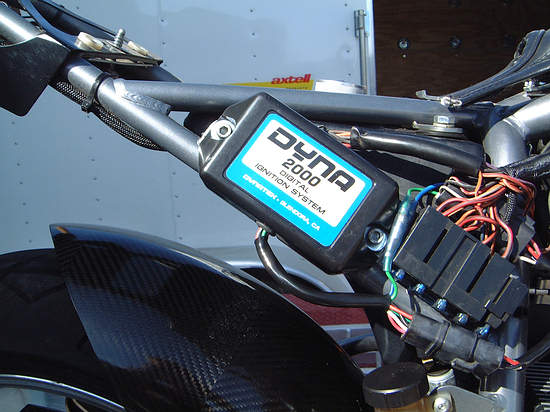
The single fire ignition chosen for the test was the venerable "Dyna 2000" from Dynatek, Inc (part number DD2000-HD1E8 for '96 and newer Buells). This module is reasonably priced, has a basic set of features useful for a mildly modified engine, and is a very popular and proven unit. It features four selectable advance curves with different final timing values, selectable rev limits from 6000 to 7500 rpm in 500 rpm increments, and a dual function VOES/retard input, the latter of which is useful in nitrous applications. The identical module is also sold at your local Harley boo-teek under the "Screaming Eagle Selectable Curve Racing Ignition Module" name (part number 32654-98).
Other single-fire modules are available from various manufacturers that include additional features such as more programmability in the curves and independent front/rear cylinder timing control. Consider these types of features if the modification level of your engine warrants it, for example, if running very high cylinder pressures on the borderline of detonation.
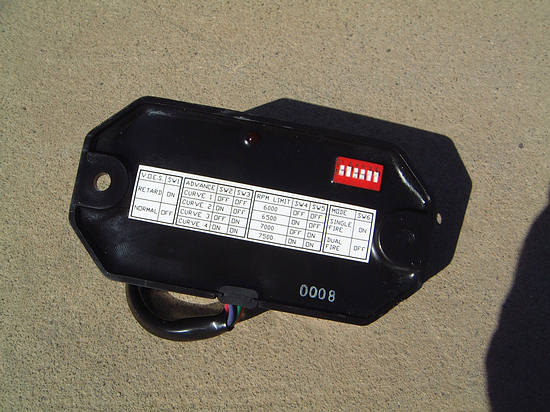
The Dyna module comes with very complete directions and installation is a snap. It mounts nicely in the stock location and plugs directly into the stock harness, utilizing the stock pickup. You'll have to route two extra wires to support single-fire operation: a separate coil primary wire for the front cylinder, and a tach output which is needed because the frequency of the each primary signal is cut in half in a single-fire application. Set the base timing by placing the front cylinder at TDC and rotating the timing plate clockwise until the LED just turns off, choose your rev limit and curve, and you're done.
So how can the Dyna module generate independent front/rear coil primary signals from one pickup? According to Dynatek, the module always runs in dual-fire mode on initial startup. If you've selected single-fire mode, somewhere around 500 rpm it will determine which signal from the pickup belongs to which cylinder based on the timing between the pickup pulses (remember the uneven firing thing). Not all single fire ignitions work this way; some require dual independent pickups and a special timing cup.
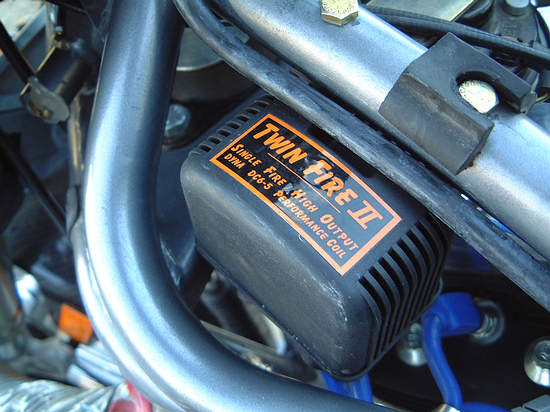
We paired the Dyna 2000 module with Dyna's popular DC6-5 "Twin Fire II" coil. The DC6-5 coil is two independent coils in one package, and is only slightly bigger than the stock coil. It fits in the stock S1 coil location with only some slightly longer bolts and spacers needed.
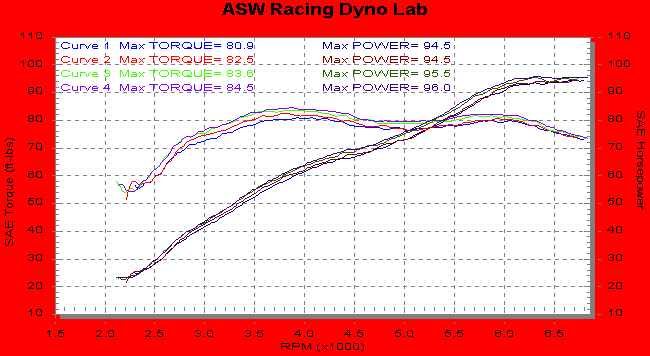
Dyno pulls were performed in single-fire mode, for each of the 4 selectable curves (see figure 1). The best result was achieved using curve 4 (the least aggressive curve available). The base timing was then varied, to see if there was anything more, but we were unable to realize any improvement.
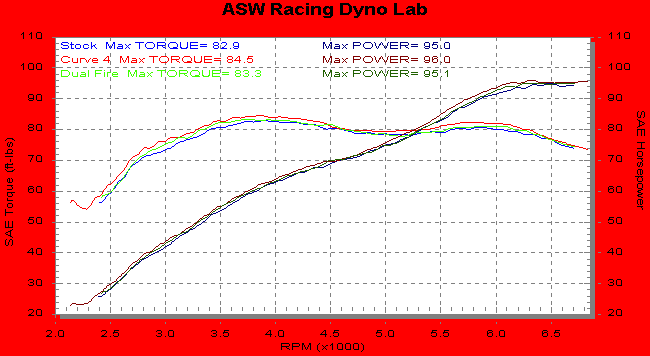
Next, the same procedure was repeated in dual-fire mode. The best dual-fire result was achieved with the same curve and base setting as the best single-fire result, and came in just a little bit shy of the single-fire results.
Both results, along with the result from the stock system, are shown. As you can see, the Dyna system didn't offer any improvement over the stock pieces when run in dual-fire mode, but did manage to eek out a small victory when run in single fire mode, and it's an advantage that spans the full rpm range.
So why didn't all this fancy ignition stuff bring more to the party? Well, put simply, at this mild level of modification the stock ignition parts are not really constraining the engine. The stock system is delivering enough spark to light the fire all the way up to it's more-than-adequate 6800 rpm rev limit and the curve is reasonably well matched to the engine's needs. We simply haven't altered the engine enough to mismatch it to the stock ignition. Even DynaTek does not make any claims of increased horsepower when using these parts on near-stock engines.
Now, if we had made modifications that increased the cylinder pressure, or improved the overlap event effectiveness, or improved the breathing such that more rpm was useful, it's entirely possible (and somewhat likely) that the aftermarket components would've made a larger difference.
Aaron Wilson
NRHS
-----------------------------
Additional commentary
-----------------------------
The above was written for Battle2win and never published. Here are some of my thoughts on it ...
This result surprised me. I truly did not expect single-fire to show up on the dyno. I've tested it extensively on another bike (my FXR) which is similarly cammed, and I've never been able to get it to show up. But that bike doesn't have as good of an exhaust system as this one.
I did several experiments to prove to myself that it really was the single fire mode showing up on the dyno, and not, for example, the hotter Dyna coil, or it wanting a different timing setting for the dual fire versus single-fire. I really pounded on the bike that day, doing something like 130 pulls. The answer was indisputable, single fire truly was adding just a little bit, and it was single fire doing it, not the coil or how the timing or curves were adjusted.
I COULD NOT, however, detect any difference whatsoever in vibration level. I literally ran the bike at various rpm's and speeds and switched the module back and forth, listening and feeling as closely as I could, and I detected nothing at all. The single/dual fire switch is the one switch on the Dyna 2K that does not require a power cycle to take effect, and I verified that the modes really were being changed by watching the tach. I had left the tack hooked up to one side of the coil instead of the dedicated tach wire, and sure enough, when I'd flip the switch to single fire it'd go to half-speed.
So there it is. Next time someone tells you that single-fire does nothing for horsepower, tell them it might, under the right conditions.
One other note ... I was tuning a bike recently that had a rear cylinder timing offset adjustment. I've messed with them a couple times before and saw essentially nothing to be gained. On this bike, though, I saw it jump a good solid 2hp by retarding the rear slightly from the front. Surprised the hell out of me, but it was real. On some bikes, it may be a worthwhile feature to have. The bike in question had pretty high compression and was making north of 110hp on stock displacement.
Aaron Wilson
NRHS
| Author |
Message |
    
Littledog1
| | Posted on Monday, October 28, 2002 - 08:08 pm: | 





|
This is far and away the clearest description of the Buell's ignition cycle and analysis of single vs. dual fire that I have read.
THANK YOU VERY MUCH!
Mickey |
    
Tripper
| | Posted on Monday, October 28, 2002 - 08:19 pm: | 





|
Glad I saved my money. |
    
Sarodude
| | Posted on Monday, October 28, 2002 - 09:00 pm: | 





|
Aaron-
Thanks for posting this FAN-FREAKIN-TASTIC info. Again, it's sad the B2Win is gone but it's SOOOO great to see this info made public.
Cool!
-Saro |
    
Blake
| | Posted on Monday, October 28, 2002 - 10:35 pm: | 





|
Way cool! Thanks Aaron!!! |
    
Kcbill
| | Posted on Tuesday, October 29, 2002 - 01:04 am: | 





|
Thanks Aaron for the info. Congrats on the Bonneville effort. Sad to hear about your dog. I remember it was having trouble getting around. |
    
Ara
| | Posted on Monday, March 31, 2003 - 10:10 am: | 





|
Aaron, this is excellent. I ride fairly conservatively so the extra 1 bhp and 1ft/lb is something that I'd never see, and with the proof that there's no change in vibration level I'd never feel the difference either. Thank you, sir. I really appreciate the scientifically rigorous methodology. |
    
Used_96_s1
| | Posted on Monday, October 13, 2003 - 02:55 pm: | 





|
I recently picked up the Screaming Eagle version of the ignition and had assumed it must be the Dyna in orange,black and white clothing, so this confirms it (I installed it just last night before dinner). The reason for purchasing it was to go along with some planned engine mods on the FXDL that will benefit from raising the redline to 6,000. However, after some deep thought on how the timing could be proper with one pickup and the cylinders offset by 45 degrees, I've been scratching my head a lot lately. After reading the 'skinny' on how the Dyna unit differentiates between which cylinder is firing when for proper timing BTDC, I have to assume that the stock module must also make a differentiation, or it would at best fire the rear cylinder ATDC.
Although I can now rest easier knowing that HD has taken this dilemma into account, it makes me wonder how this situation would be handled on an older bike that runs breaker points.
I did read somewhere that a single fire will give a slightly smoother idle on bikes with a higher amount of overlap. Thanks for doing the dyno run and publishing the results.  |
    
Al_lighton
| | Posted on Wednesday, April 21, 2004 - 09:32 pm: | 





|
Ya know, I just read this article after a year and a half after the first reading, and it is just excellent. If you took any technical courses with labs in college, remember having to do the lab reports? They took lots of time, and a good lab report always included the stuff you had to do before the lab ( Purpose, Theory, Procedure, and the blank data table), then you did the test, filling in the data table, then you wrote the observations, results, and conclusions. I got pretty good at lab reports (at least grade-wise) and even kinda enjoyed those classes, but the reports were DRY DRY DRY!!!!!
Aarons article has got all that stuff in it, but it is cleverly disguised within nice text that is an entertaining read...well, OK, a tad geeky, but us fellow geeks like it that way  . .
Nice.
I wish Battle2win had stayed around, because we would have gotten a lot more articles like it...Sigh.
Al |
    
Rick_a
| | Posted on Wednesday, September 07, 2005 - 08:38 am: | 





|
My theory on this is that single fire develops a hotter, fatter spark due to not having to share the coils output to two plugs, and that is what gives the slight power increase.
I can tell you for sure that my N9 cammed S1 was no smoother idling or running with a high output single fire system...but it was capable of igniting a terribly rich mixture! |
    
Buellistic
| | Posted on Wednesday, September 07, 2005 - 01:37 pm: | 





|
The reason the old INDIANs flatheads would out run the old Harley-Davidson flatheads is because the Indians had single fire ignitions !!!
In BUELLing
LaFayette |
|
 »
Dyno Test Results - Dyna 2000 Single Fire Ignition
»
Dyno Test Results - Dyna 2000 Single Fire Ignition
 »
Dyno Test Results - Dyna 2000 Single Fire Ignition
»
Dyno Test Results - Dyna 2000 Single Fire Ignition




